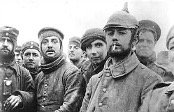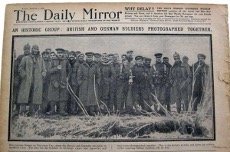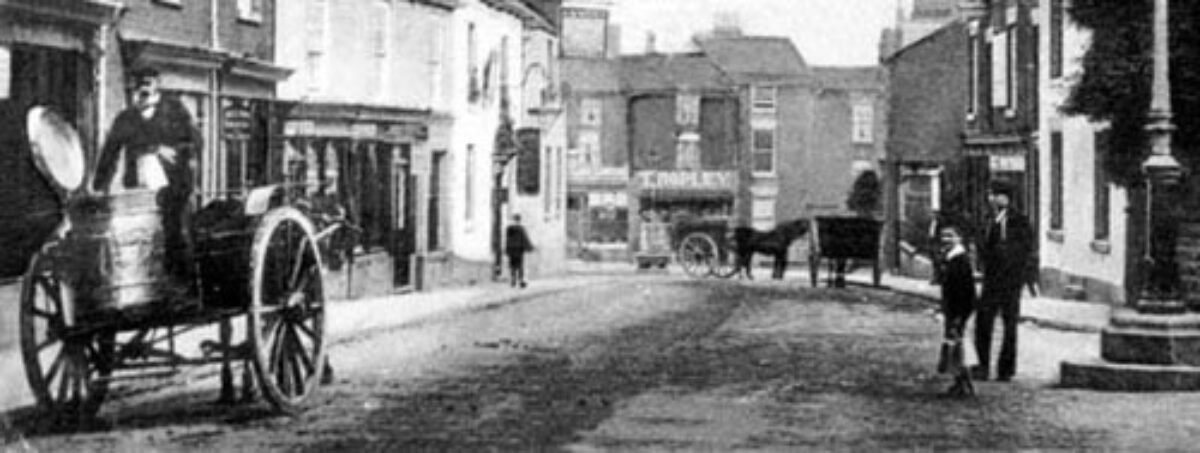British forces on the Western Front now comprised shattered remnants of the British Expeditionary Force’s regular army. Our units were hurriedly being rebuilt by drafts from India and the Territorial Army. December was marked by static warfare in appallingly wet and cold conditions in crude trenches. Sometimes only 50 yards separated the two front lines. There were occasional shouted greetings and insults but under strong French pressure to take the initiative, we undertook a few piecemeal attacks that cost us dearly; many decomposing bodies from both sides were left in No Man’s Land or impaled on barbed wire.
Neutral countries and Pope Benedict XV appealed to the warring nations to keep the peace at Christmas – these entreaties initially fell on deaf ears. However, even though both high commands encouraged an offensive spirit and forbade fraternization, a “Live and let Live” attitude emerged in the days leading up to Christmas. Just over 50 British units held the about 30 miles of the line; these units included the 1st and 6th Cheshires on the Wulverghem-Messines road. Opposite them for the most part were the Westphalians, Bavarians and Saxons (mercifully no elite professional Prussians or Thuringians). The festive spirit increased as gifts arrived from families or the state. “Tommy” received plum puddings and 355,000 “Princess Mary boxes” – metal cases embossed with an outline of George V’s daughter and filled with butterscotch, chocolates, cigarettes and tobacco, a photo of the Princess and the King’s greeting “May God protect you and bring you safe home”. “Fritz” got gifts from Kaiser Wilhelm II – the “Kaiserliche” a large meerschaum pipe for the soldiers and boxes of cigars for officers and NCOs. The troops were overwhelmed with presents, clothes and letters of thanks sent from home.
Christmas Eve was a good day weather wise. Rain had given way to frost and clear skies. The mood shifted. Tannenbaume arrived on the enemy side – they were lit with candles and strung along the parapets – creating a perfect atmosphere for jeers and songs. Rations were thrown. Respite bubbled up from the ranks. It must be said that the initiative for a spontaneous truce seems to have come from the Germans. Most exchanges were in English for many Germans had lived and worked over here before the Great War as waiters, cabbies, shopkeepers and barbers. The words of the carol “Stille Nacht” drifted across the front. We applauded and replied with “O Come All Ye Faithful”. The Germans then sang it in Latin and so it went on. “We no shoot. You no shoot” was heard in many locations. Men began tentatively to crawl out of the trenches and mix in No Man’s Land. Lots of Company officers up to the rank of Colonel pretended not to notice this court martial offence and joined in. The impromptu cease fire largely held for 2 days. Items were exchanged – food, drink, tobacco, photos, postcards, buttons, hats. Addresses were swapped. The dead were often removed or buried, sometimes in joint graves. Prayers were said in both languages.
Football matches took place. A Swedish author, Pehr Thermaenius, maintains there were at least 15 such ill-organised encounters – some with a ball, often with rations tins, sandbags or hats stuffed with straw. Results are known for 4 of these matches. One was a draw. Germany won 3-2 on 2 occasions (possibly through penalties?) and we actually won one 4–1 – another Christmas miracle!
In 1983, Ernie Williams a former Territorial of the 6th Cheshires, said in a TV interview: “The ball appeared from somewhere … it came from their side. They made up some goals … in a general kickabout. I should think about a couple of hundred took part. Everybody seemed to be enjoying themselves. There was no sort of ill-will between us. It was simply a melee, no score was kept, the boots we wore were a menace and in these days the balls were made of leather and they soon got very soggy.” His fellow soldier, Company Sergeant Major Frank Naden told the Newcastle Evening Mail when home on leave in Stockport: “The Germans gave us some sausages … we gave them our chocolate. The Scotties started the bagpipes and we had a rare old jollification. The next day we got an order that all communication … must cease, but we did not fire at all and the Germans did not fire on us.” (Evening Mail, December 31st 1914.)
The Christmas idyll was not perfect. Accidental gunfire led to some deaths. The struggle continued unabated in spots, in fact 61 British soldiers died on Christmas Day. The truce was not as widely observed by the French or Belgians perhaps because they were anxious to rid their homelands of the invaders. Unavoidable pressure from the “brass hats” saw the dissolution of the truce. Men were forced to restart history’s most horrific conflict to date. It was so long and bloody that it lasted just short of the 5th Christmas.
Undoubtedly mythologized, the Christmas Truce has however inspired many songs, paintings, literature, films and other art. Its enduring legacy has been positive – a wonderful message of hope and the triumph of the human spirit over adversity.
A long way from the mud-soaked fields of Flanders and France, Wilmslow had a December casualty. He was a Wilmslow born Territorial, Private Francis Shaw who enlisted in Manchester in their 1st/8th battalion Manchester regiment. He died in Egypt on 18th December, probably of disease as no action took place at that time. He had been sent to defend the Suez Canal against the Turks. He is buried in Alexandria (Chatby) Military Hospital and is commemorated in St Bart’s, on the family grave in the churchyard and on the Wilmslow Memorial.

Riflemen with men from two of the Saxon regiments


Jon Armstrong and Alan Cooper with a contribution from Adrian Lennard
